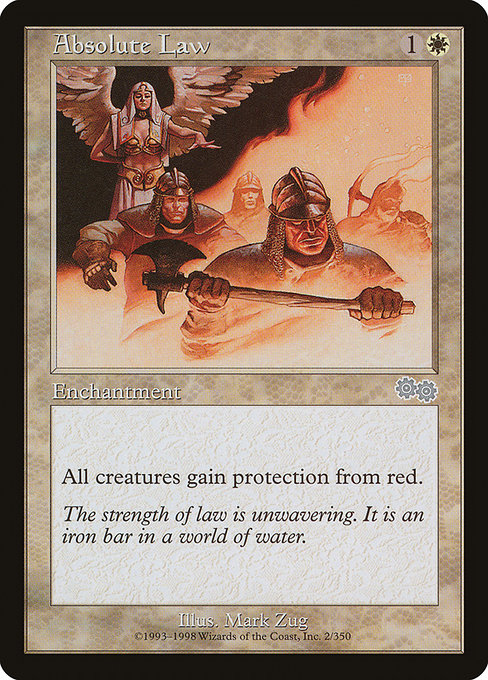
Image courtesy of Scryfall.com
Understanding power and toughness ratios on the battlefield
MTG combat is a dance of numbers, timing, and sometimes stubborn stubbornness. When you drop a white enchantment like Absolute Law, you’re not just playing a policy card—you’re bending the very rules that govern how creatures trade blows. This old-school Enchantment from Urza’s Saga says, simply, “All creatures have protection from red.” On the surface it’s a clean, game-changing line, but it also reframes how players think about power and toughness in every combat step. 🧙♂️🔥💎
Absolute Law at a glance
In the sparkly intersection of flavor and function, Absolute Law costs {1}{W} and is an Enchantment from the legendary Urza’s Saga set. Its colors lean white, its rarity is uncommon, and its typography sits in that crisp late-90s frame. The card’s text is straightforward—everyone’s favorite universal shield: "All creatures have protection from red." The art, by Mark Zug, captures a stern, iron-bound ideal of order amid a rough, watery world. The flavor text—“The strength of law is unwavering. It is an iron bar in a world of water.”—reminds us that purity of law isn’t flashy; it’s steady, like a well-timed block. 🎨⚔️
- Mana cost: {1}{W}
- Type: Enchantment
- Text: All creatures have protection from red.
- Colors: White
- Rarity: Uncommon
- Set: Urza's Saga (USG)
- Flavor text: The strength of law is unwavering. It is an iron bar in a world of water.
Flavor text gives us a window into a world where order stands against the chaotic, color-driven maelstrom of battle. Absolute Law isn’t a punchline; it’s a lens for evaluating how protection from red reshapes every P/T duel across the board.
So what does protection from red really do in combat? It’s a layered concept that touches several dimensions of the fight. Protection from red means a creature can’t be targeted by red sources, it can’t be enchanted or equipped by red sources, and it can’t be damaged by red sources. In practical terms, that changes who can damage whom, who can be blocked by whom, and how damage spills over in the middle of a clash. That’s where the idea of a “power-to-toughness ratio” gets interesting: raw stats aren’t the only number that matters—the color of your opponents, and the protections on the field, can swing the expected math of a block or an attack. 🧙♂️🎲
How protection from red shifts combat math
Protection from red creates a set of edge cases that pure P/T numbers don’t capture. Here are a few takeaways you can apply when you’re drafting or laddering a white-centric lineups around Absolute Law:
- Damage from red sources is prevented. If a red creature attacks a protected creature, the attacking creature’s power is effectively useless against that defender in the damage step. The defender still posts its own damage back, but the red attacker often trades unfavorably. This tilts the battle in favor of creatures that can block red threats without needing to out-muscle them on raw numbers. 🛡️
- Red-heavy boards stall against protection. White creatures protected from red shrug off a lot of typical red removal lines and can hold the line longer, especially when backed by a resilient curve. The “ratio” in such boards becomes less about flipping a single trade and more about who can sustain blockers and maintain board presence. ⚔️
- Blocker targeting and color lines. A protected creature can still be blocked by any color; protection only prevents targeting by red sources and damage from red sources. That means red attackers can still pressure a protected board via non-red support or pump spells, but they must respect that the creatures they’re hitting carry a built-in shield. 🧊
In practice, Absolute Law nudges the match toward white’s resilience and strategic tempo. It’s not about boosting P/T numbers in a vacuum; it’s about creating a battlefield where the usual red-centric breakpoints are softened and where tactical plays—such as well-timed blockers, lifelink, and value-generating white staples—shine brighter. The card invites you to think in terms of “how many trades can I win if every defender has a color-based shield?” rather than “how big is my creature?” And that shift is a delightful mental workout for any MTG deckbuilder. 🧙♂️🔥
From a lore and design standpoint, Absolute Law embodies a classic White theme: order, purity, and a sense that some forces are just beyond subterfuge. The art and the flavor text reinforce that notion of an iron discipline in a chaotic multiverse, reminding us that sometimes the strongest weapon is a well-told rule. It’s a reminder that power is often about how you play to your strengths, not just how much you swing for each turn. 💎
If you’re curious to put this philosophy into practice, consider pairing Absolute Law with a control-white shell or with aggressive white creatures that excel at robust blocking, such as kithkin or soldiers from older sets. The combination encourages you to weigh every combat decision with care—just as any true MTG veteran knows, the numbers tell a story, but the strategy writes the ending. 🧙♂️🎲
On a desk note that will please the TCG desk jockey in all of us, an eye-catching mouse pad can accompany your tabletop sessions, just like this neon example — a little neon-bright energy for those long nights of cracking packs and plotting lines of play. If you’re in the market for a new setup, check out the Neon Gaming Mouse Pad 9x7 Custom Neoprene Stitched Edges 2, a stylish companion for those epic grind sessions. Neon Gaming Mouse Pad 🧙♂️
More from our network
Curated readings and cross-pandomic insights—enjoy these five from the network.
- https://crypto-acolytes.xyz/blog/post/top-solana-whales-to-watch-in-2025/
- https://crypto-acolytes.xyz/blog/post/exploring-johto-in-pokemon-gold-and-silver-a-guide/
- https://crypto-acolytes.xyz/blog/post/bitcoin-shapes-global-trade-and-cross-border-payments/
- https://crypto-acolytes.xyz/blog/post/final-fantasy-x-vs-xii-clash-of-classic-rpgs/
- https://transparent-paper.shop/blog/post/grow-your-audience-organically-with-simple-actionable-tactics/